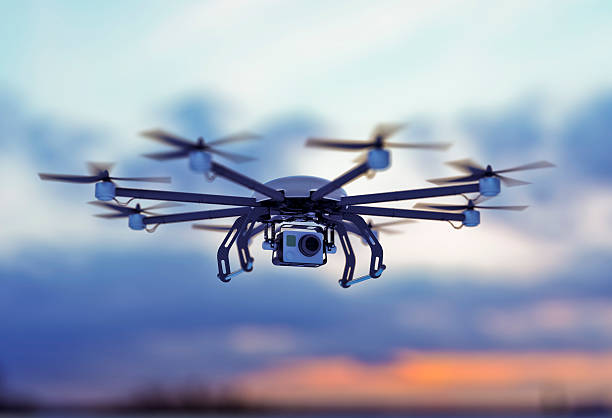The top drones for taking pictures from above

When we test the best drones, we consider a number of factors, including who will be flying, how much they will be spending, and how they want to shoot. Since what works best for one pilot may not be the greatest option for you, we’ve thoroughly examined a wide variety of drones. Every item in our roundup, which ranges from professional models to entry-level options, is suggested for a specific kind of flyer.
We believe that the DJI Mini 4 Pro is now the greatest drone for the majority of users, based on hundreds of hours of flight time. Its weight of less than 250g makes it easier to fly legally, but it doesn’t sacrifice functionality for legality. It has a robust feature set that includes dependable obstacle avoidance and a high-quality camera for aerial photography. It’s one of the finest drones for beginners because it’s easy to fly and safe for beginners.
Having said that, to get a full view of what’s available, we advise reading through to the finish. Every drone has undergone comprehensive testing in real-world environments. From flying controls and safety features to shooting modes and image quality, everything is checked by our skilled staff. We’ve selected our top drones based on the results, outlining the advantages and disadvantages to help you decide which one to buy.
Top 5 Best Drone In 2024
1.DJI Mini 4 Pro
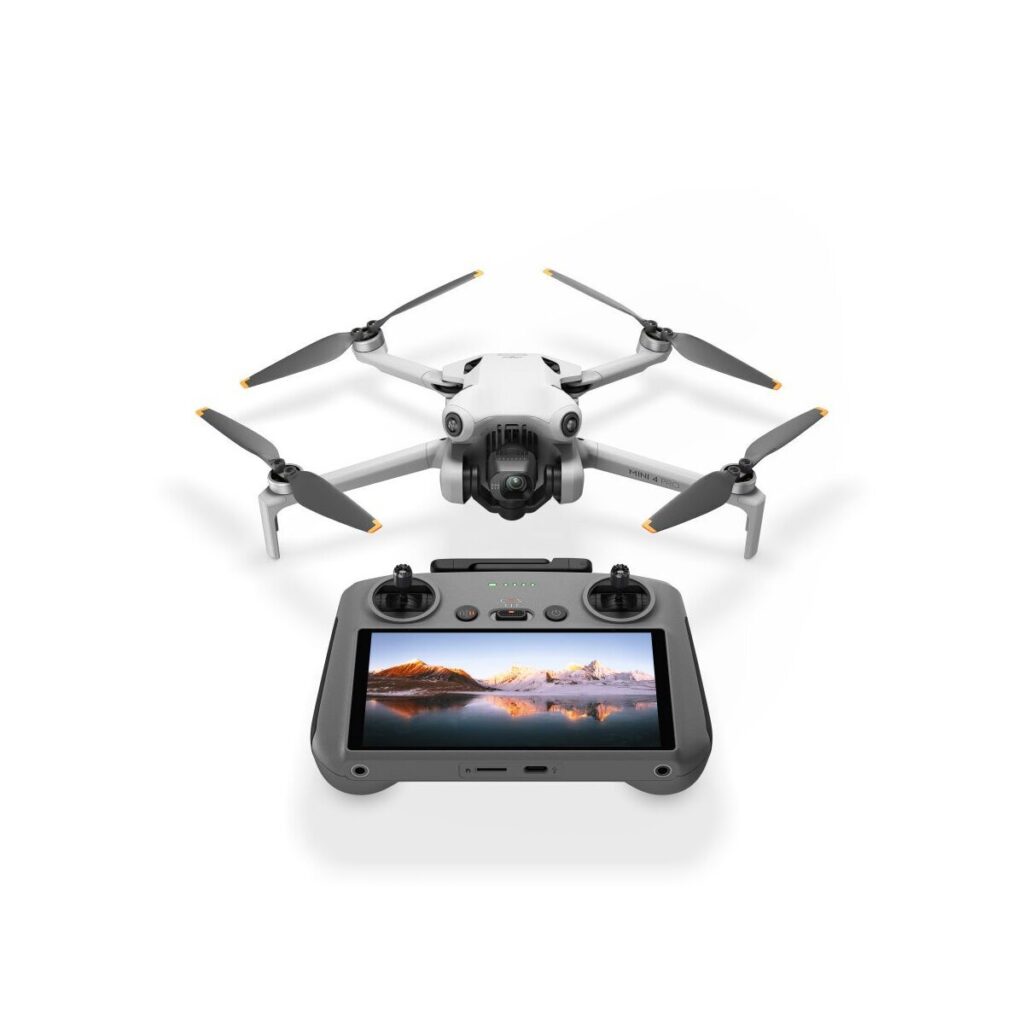
Pros
- Improved video features
- Omnidirectional Vision Sensing
- Lightweight but powerful
Cons
- Not a major upgrade
- Camera has a fixed aperture
Our favorite drone in the past was the DJI Mini 3 Pro, which has pro-grade functionality and a lightweight construction. Although it doesn’t significantly alter the experience, the Mini 4 Pro improves upon its strengths to provide an even better one. It’s unlikely that upgrading a Mini 3 Pro is warranted if you currently have one. However, it’s a great option if you’re upgrading from a different model or purchasing your first drone from the Mini series. Its compact, foldable design and regulation-friendly takeoff weight of 249g are nearly comparable to those of the Mini 3 Pro. The 1/1.3-inch sensor is likewise same and produces outstanding image quality.
We observed that it performs even better in low light conditions with the latest processing improvements. Since the D-Log M color profile delivers more consistency with the Mavic 3, serious videographers will also appreciate it. The Mini 4 Pro is even safer than its predecessor when it comes to operating indoors or in close proximity to trees because obstacle avoidance is now omnidirectional. ActiveTrack 360° is also quite effective, which makes it simple for novices to fly with confidence, according to our findings. The DJI RC 2 controller option is the greatest drone combo for a backpack, if you can afford it.
2.DJI Mini 3
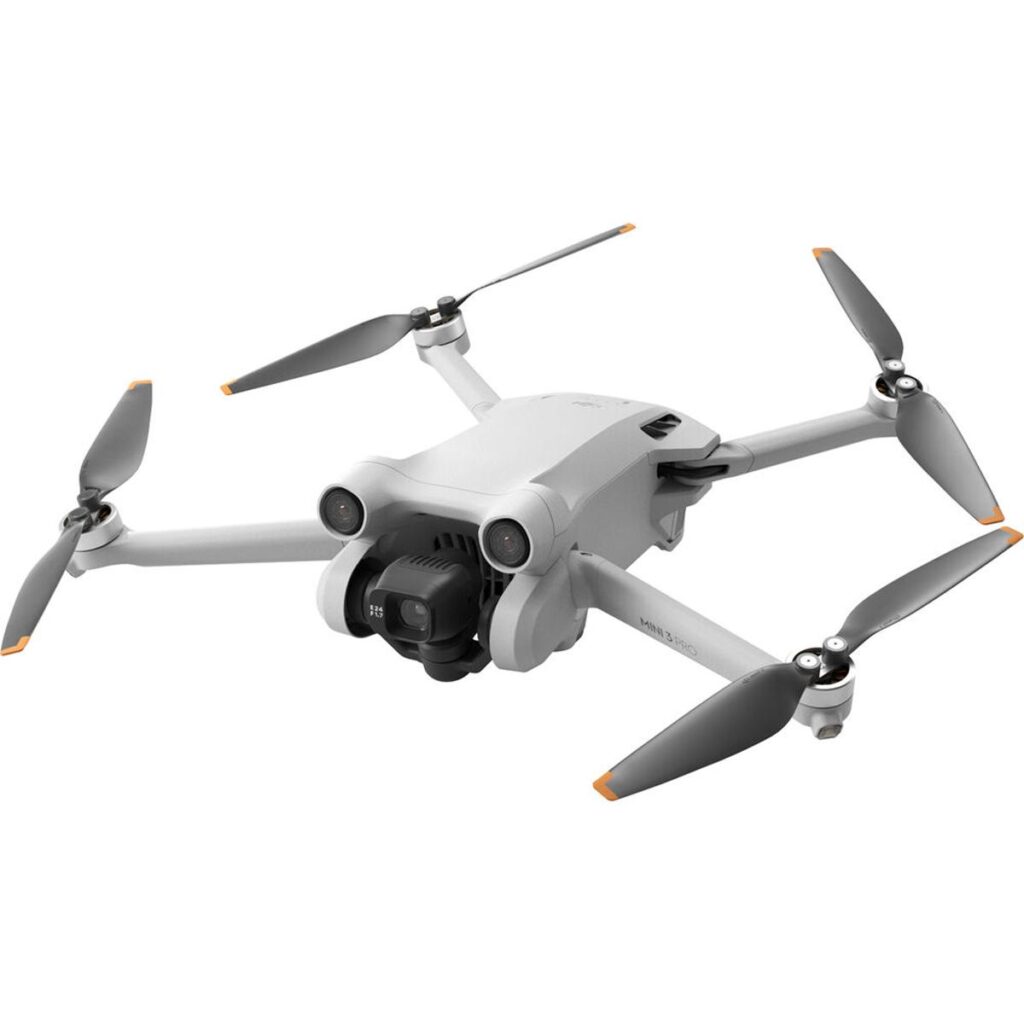
Pros
- Great image quality
- Small, lightweight build
Cons
- No collision avoidance
- No subject tracking
The Mini 3 is the best inexpensive drone available if you’re a first-time buyer because it’s lighter, smaller, and far less expensive than the Mini 4 Pro. Although it doesn’t have the obstacle avoidance that its more expensive brother has, the less expensive model still produces superb JPEG and raw photos and 4K video at up to 30 frames per second provided you’re comfortable navigating obstacles without the assistance of DJI’s automated safety feature. For social media, its 12MP sensor can also spin to capture portrait shots. The lack of log color profiles will reduce the Mini 3’s attractiveness to pros who require the flexibility of modifying video files.
Subject tracking is another noteworthy feature that is absent from amateur drones. But DJI does have a feature called Quickshots, which is great for new users as it lets them plan an automated flight path and possibly record interesting video clips. Starting off with this drone is simple, especially if you have it equipped with the optional controller, downward vision sensors, and GPS for accurate hovering. Pro drones like the Mavic 3 Classic will provide you greater image quality and more stability in windy circumstances, but for those on a budget, the Mini 3 is the best option.
3.DJI Mavic 3 Pro
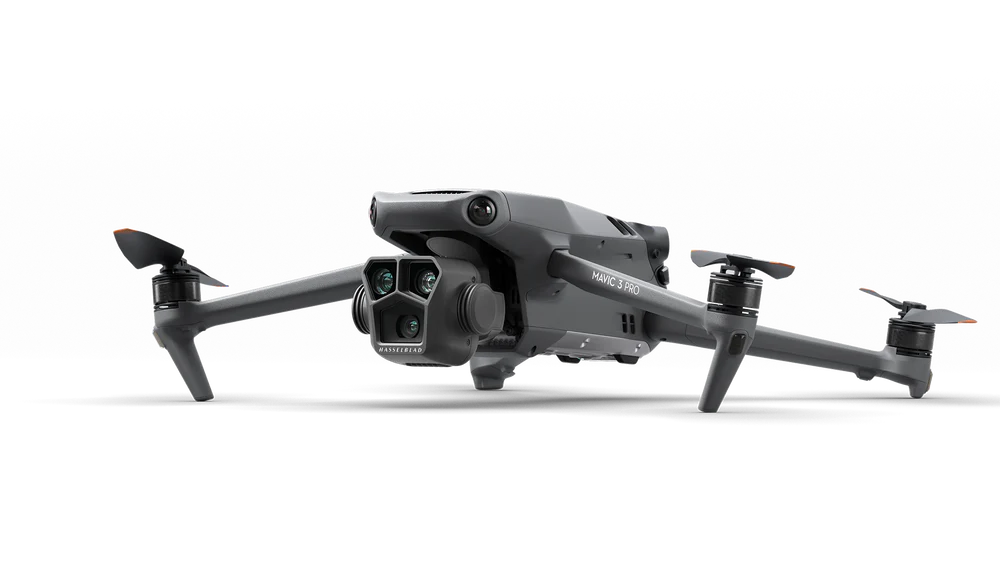
Pros
- Superb Four Thirds camera
- Triple-camera system
- Adjustable aperture
Cons
- Pricier than rivals
- Some missing features at launch
With good reason, the Mavic 3 Pro took home the perfectpicks Choice Awards 2023’s best camera product of the year title. Being the first consumer drone with three cameras, it’s perfect for filmmakers and aerial photographers that require the most adaptable drone available. The primary camera of the Mavic 3 Pro and Mavic 3 Classic is the same 20MP Four Thirds sensor that provides the highest quality images out of all three when combined with an adjustable aperture, pro-level video formats, and frame rates. Having said that, both the 3x and 7x telephoto cameras generate fantastic shots if you require more reach than the camera’s standard 24mm focal length.
Despite being in the C2 European drone category due to its weight, the Mavic 3 Pro is nevertheless an extremely easy drone to fly, even in windy situations, and accessible to all users because to its great safety features and simple controls. Its high cost, which renders it unnecessary for novices, is another drawback. On the other hand, compared to the Inspire 3, it is even more versatile and more affordable for pros.
4.DJI Air 3

Pros
- Dual cameras
- Excellent wind resistance
- Generous flight times
Cons
- C1 European weight rating
- Fixed aperture lenses
- Large protruding camera
The DJI Air series, of which the most recent model is the Air 3, is clearly positioned between the Mini and Mavic Pro series of drones. A sub-250g model such as the Mini 3 will be easier for beginners to handle than the Air 3, but the larger model offers a healthy 46 minutes of flight duration along with significantly greater wind resistance. Additionally, we believe that novices will rapidly become accustomed to the Air 3’s user-friendly interface and security features, like obstacle avoidance.
The Air 3 is classified as a drone in Europe’s C1 category, which has flight regulations requiring you to maintain a greater distance from people, animals, and events in order to be safe and compliant. The Air 3 weighs 720g at takeoff. The Air 3’s new 3x telephoto lens, however, allows you to still get up close and personal with the action. The two cameras of the Air 3 have exceptional image quality and are quite versatile. Although its fixed aperture lenses can be challenging to use when filming in varied light conditions with ND filters, the Air 3’s 3x zoom lens makes it a far more adaptable aerial camera than the Air 2S.
5.Autel Evo Lite+
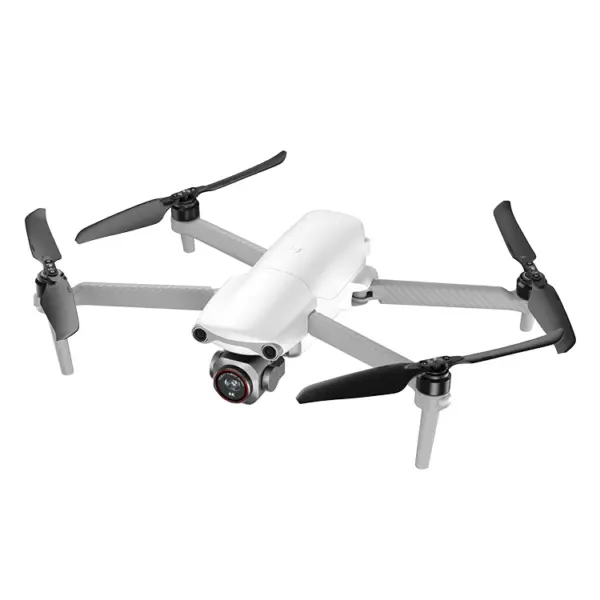
Pros
- 1-inch sensor with adjustable aperture
- 40-minute flight time
Cons
- Costs more than Air 2S
- No D-Log profile
The Evo Lite+, the flagship drone from Autel’s most recent lineup of DJI competitors, directly faces off against the Air 2S. It has a very similar specs sheet and can capture 5.4K video at 30 frames per second with a 1-inch sensor. But with to its 40-minute flight length and variable aperture (which ranges from f/2.8 to f/11), it also outperforms the Air 2S and the Mavic Pro 2. The Lite+ model’s bigger sensor pixels allow it to capture more light in low light than its Evo Lite brother, although lacking the latter’s fourth-axis stability.
The absence of D-Log profile and 10-bit footage may cause professional drone videographers to reconsider, and it is unfortunate that side sensors for obstacle avoidance have been left out. However, in every other way, our review revealed the Lite+ to be an incredibly adaptable flying camera tool. Its 20MP sensor is arguably the greatest drone camera currently on the market for the money, giving the Air 2S some fierce competition.
How to pick the ideal drone for your needs
The first thing you should consider while selecting your perfect drone is your budget. Largest sensors, maximum video resolutions, and the newest pro-grade capabilities are typically found in flagship drones, although these typically cost thousands of dollars. In the middle of the spectrum, where devices like the DJI Mini 3 Pro strike a mix between cost, portability, and performance, you’ll frequently discover the best deal. The Ryze Tello, which costs just $99 / £99, is a good option for those who are new to drone flying and are looking for an inexpensive drone to get started.
Drones with safety features like obstacle avoidance, which lessen the chance of mid-air collisions, are a good option for novice pilots. Additionally, set-piece maneuvers can be easily executed without the requirement for expert flying abilities thanks to automated flight modes. Similar to this, follow-me drones eliminate the work involved in following a target.
The majority of drones let you use your smartphone as a controller by simply sliding it into a built-in handset. Verify which remotes work with a particular model if you’re an experienced pilot with certain control needs. Depending on how you intend to fly, variables like flight duration, range, and speed may also be exceptionally important.
It’s important to consider your photo and video usage strategy if you intend to take aerial photography and films. Stabilized Full HD footage might suffice if you plan to post it on social media. However, you should search for a drone with a large sensor that can capture 4K footage and support color profiles for more editing freedom if you’re making a short film or even if you’re working for a living.
Lastly, consider your weight and size. The fact that a lot of the drones seen above can be folded down to fit in a backpack makes them more portable. Though they are less transportable, larger drones are usually more stable in the air. Drones weighing more than 250g are probably going to need to be registered.
FAQS
Which laws apply when using a drone?
In particular, legislation governing drone use are in place to guarantee a high standard of safety in the air, particularly in proximity to airports and national parks. Additionally, they want to resolve privacy issues that crop up when camera drones are flown over residential areas.
Drones weighing less than 250g are excluded from registration requirements with civil aviation authorities in a number of regions, including the US. Even though it may not be required, it is still important to abide by local drone rules. This includes the need to always maintain visual contact with your drone when it’s in the air.
Regulations vary throughout nations. Drones under 250g were previously excluded from registration in the UK. The requirement to register an aircraft with the Civil Aviation Authority and get an Operator ID has been modified for owners of drones equipped with cameras. The annual cost of this registration is £10.33 for those who are eighteen years of age or older.
You will also need a Flyer ID if the weight of your drone is more than 250g. You must complete an online test with 40 multiple-choice questions in order to receive this. The Drone Code contains the solutions, which are meant to encourage safer flying techniques.
Neither ID is required for drones without cameras that weigh less than 250g. Nevertheless, you must still abide with UK drone regulations. The Drone Code states that you must keep visual contact with your drone at all times, fly no higher than 120 meters above the ground, keep a minimum of 150 meters away from inhabited areas, and stay out of restricted airspace, which is usually located close to airports.
Do US laws prohibit DJI drones?
Chinese drone manufacturer DJI was included to the US government’s “Entity List” in December 2020. Huawei had already been placed on this trade blacklist in 2019. The purchase or use of DJI drones by US federal agencies is now forbidden, and the use of these drones by government agencies is outlawed in a number of states, including Florida.
Nonetheless, individual consumers are still able to purchase and operate DJI drones legally in the US, and there is no indication that DJI will be prohibited from offering its goods for sale to consumers. All that the trade blacklist does is limit its future product access to US technologies. Thus, even while it might have an impact on DJI’s supply chains, the company’s drones are still being sold by all of the major retailers, including Amazon.
Although the choice to purchase DJI drones is a personal one, we are glad to continue endorsing its flying cameras. The US blacklist decision has been hotly contested by DJI, which claims that it “has done nothing to justify being placed on the list.” Additionally, it has been declared that “DJI is not a military company in China, the US, or any other country.”
Who produces the greatest drones?
When it comes to drones with cameras, DJI has been the industry leader for many years. Even if that is still the case, the Chinese business has recently faced criticism due to heightened competition as well as encounters with the US government. As you can see from the above, this hasn’t altered our recommendation on whether or not you should get a DJI drone, but it is encouraging to see some healthy competition in the drone market.
Because of its ability to avoid obstacles, Skydio has become a well-known brand in the US and is a serious competitor for users who require “follow me” capability. Unfortunately, Skydio has shut down and is no longer involved in the consumer drone market, meaning that DJI has lost a competitor. More recently, Potensic unveiled the Potensic Atom, a superb DJI Mini 3 substitute for novices, and we were thrilled by the products from another Chinese business, Autel, which is producing very nice DJI rivals at various price points. Though there are many options now, especially if you have a specialized use case for a flying camera, we still believe that DJI is the finest drone brand overall.
How we test drones
While the drones we examine are mostly focused on their cameras, we also assess their flying performance to determine how user-friendly they are. We evaluate safety aspects that are important for high-performing drones, such as the efficiency of obstacle avoidance, the drones’ stability in flight, especially in windy situations, their actual top speeds, subject tracking features, and the presence of latency.
We first evaluate the drone’s battery life promises using a few actual flights before moving on to looking at its cameras. We can capture like-for-like films using the drone’s range of color profiles, maximum resolution (Full HD, 4K, 5,3K, or in some cases 8K), and at the different frame rates available by taking flights during the day and in low light. Additionally, automated flight modes are examined to determine if they are entertaining gimmicks or actually helpful.
Then, we evaluate these films on a calibrated monitor in conjunction with the still images captured by the drone (which we take at different ISOs and at maximum resolution in both JPEG and raw). What qualities distinguish a strong image? On the other hand, the camera sensor must be able to effectively manage noise at the high ISOs required for low light photography in order for the lens to provide fine detail from edge to edge with the least amount of fall-off in the corners. These tests inform us of the drone’s camera’s reasonable limitations. To arrive at our ultimate decision, we next integrate these findings with our general assessment of the drone’s characteristics, design, and worth.

